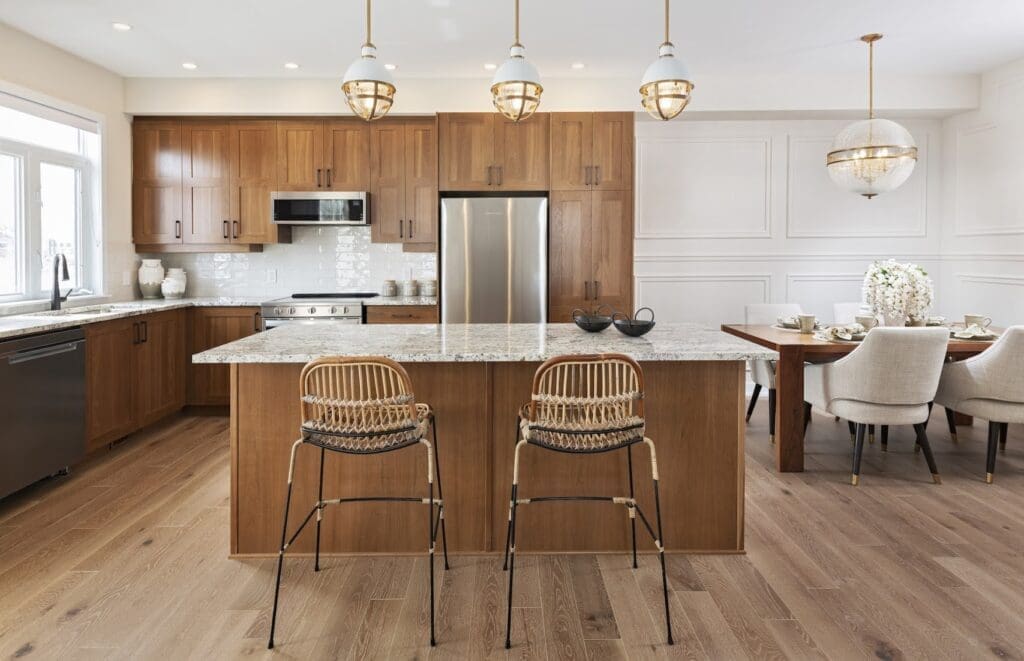Your wooden cabinets go through a lot, without you even noticing it. Last year, while you were having friends over for dinner, you spilled red wine on them. Young kids are not aware of their value and your four-year-old dropped spaghetti sauce and didn’t remove it right away, leaving an unsolvable stain. Well, today, we’re giving you advice on how to properly maintain your wooden cabinets.
SEASONAL CHANGES
First off, you need to know that wooden cabinets go through seasonal changes. While excess humidity from wet seasons will not directly affect the finish, it can contribute to other situations, possibly aggravating them. You might see some seasonal movement; swelling of doors and drawer fronts in the warmer, humid months, and shrinkage when the weather turns cooler and drier. Climate control in the form of a dehumidifier can help. Extreme dryness could lead to excessive shrinkage, splitting or even popped joints. In these cases, we recommend the use of a humidifier.
HOW TO PREVENT MOLD?
Damage from moisture will have many different symptoms: blushing of the topcoat, deterioration of the finish, or black stains in the wood. Moisture damage is easily minimized or even eliminated simply by being aware of certain items:
Sink cabinet: always take the time to wipe away all water that splashes over the front of the cabinet.
Cabinetry around coffee maker: it is possible that steam coming from a coffee maker being vented directly onto the overhead cabinetry may blush the finish. If possible, the coffee maker should be located with clearance overhead.
Cabinetry around dishwasher: loading or unloading a dishwasher can cause water to splash onto nearby cabinetry. Once again, take time to wipe away all water.
Bath cabinetry: the main awareness here is to ensure your bathroom is properly vented with a fan that meets current code regulations.
CARING FOR YOUR WOODEN CABINET DOORS
For a regular cleaning for your doors, use mild soap and wipe with a damp soft cloth. Ensure to dry immediately with another soft dry cloth. Do not leave water to dry on your wooden cabinets and doors. Do not use detergents, strong soap, abrasive or self-polishing waxes on cabinets. A humidifier is recommended to prevent excessive contracting of your cabinets. Humidity levels should always be between 35% and 55% humidity.
EXPANSION AND CONTRACTION
Please be aware wood expands and contracts due to environmental changes in temperature and humidity. Five-piece cabinet doors (and multi-panel cabinet doors and wainscot) are constructed with a small amount of space in the frame groove.
This space allows the panel to float slightly within the frame, allowing for expansion of the panel due to changes in the environment, without causing the frame to split or crack.
The natural process of expansion and contraction can create open joints in the finish. An open joint line related to expansion or contraction is not considered a defect. The finish will still protect the surface, and the structural integrity of the joint will not be affected.
Wood may expand and contract differently from cabinet to cabinet and even joints within the same cabinet may behave differently. Some joined wood may not show any joint lines, other may be slightly visible, while others may display easily visible joint lines and small cracks. Joint lines also may occur due to repeated impacts from normal everyday use. An exposed open joint can be damaged from prolonged exposure to water or heavy moisture. Therefore, wipe off any excess moisture from cabinet as soon as possible.
Therefore, Potvin Kitchens and Cabinetry uses the finest, furniture grade, select hardwood available for our cabinets and cabinet doors. Because hardwoods are products of nature, variations in color and grain are to be expected. Some species of wood have unique grain characteristics that may cause the final finish to look darker in some areas.
Consistency of quality and craftsmanship, as well as the character of natural wood is to be expected in all our cabinets.
Because of the wood’s natural characteristics, variations in shades between your cabinet doors and our color samples are to be expected.
All finishes are susceptible to discoloration due to airborne particles such as cooking, grilling, smoke, fireplaces or candles. Prolonged exposure to natural or artificial light and/or moisture may alter the finish color as well.


